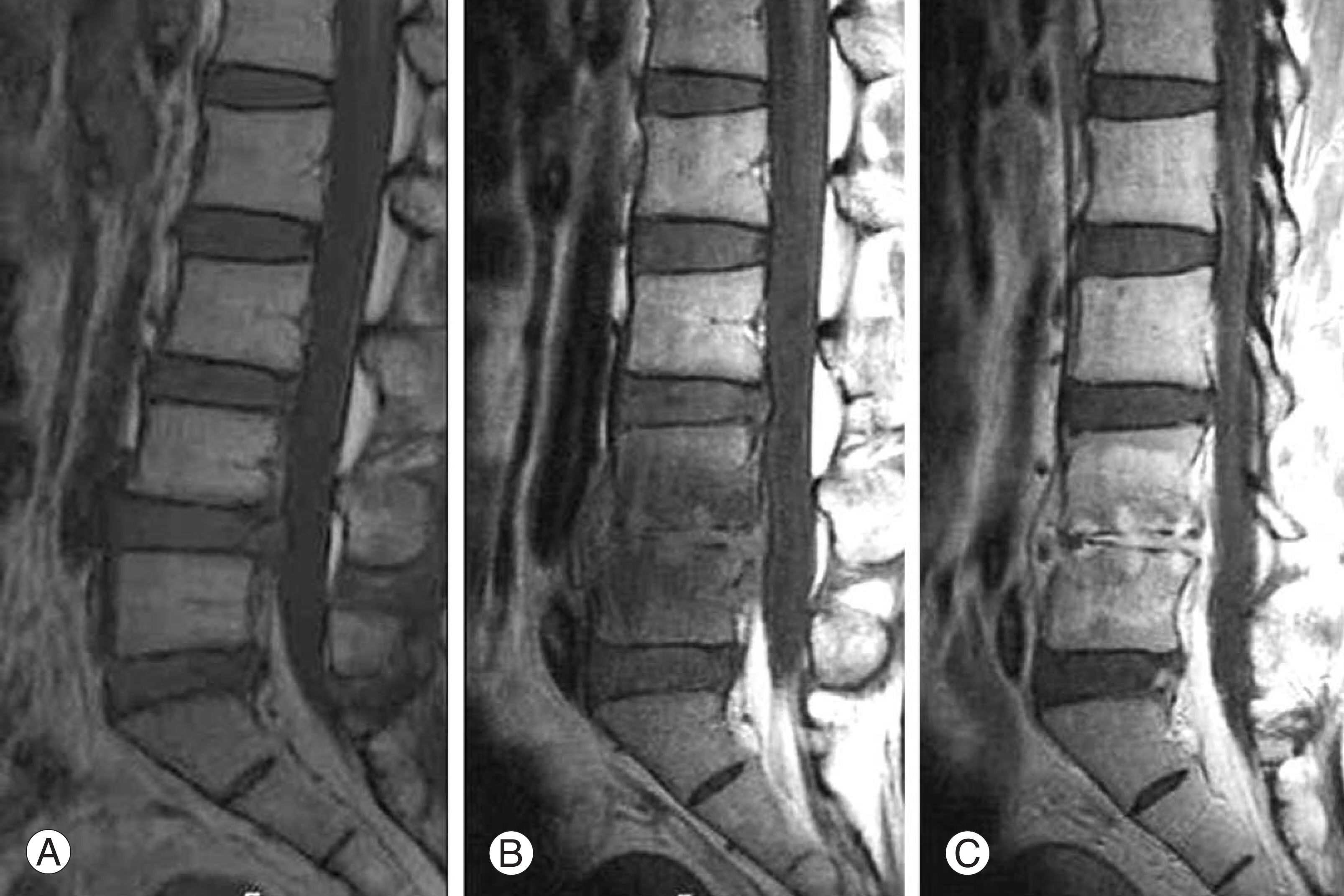J Korean Soc Spine Surg.
2006 Dec;13(4):299-305.
Iatrogenic Spinal Infection after Injection Therapy in Spine.
- Affiliations
-
- 1Department of Orthopaedic Surgery, Fatima Hospital, Daegu, Korea. fatimaos@unitel.co.kr
Abstract
-
STUDY DESIGNS: A retrospective study of clinical experience.
OBJECTIVES
To investigate and report the iatrogenic form of spinal infections that occur after injection therapy in the spine. SUMMARY OF LITERATURE REVIEW: An iatrogenic infection after injection therapy in the spine is rarely reported to be a serious complication. However, an increase in the number of immunocompromised patients, the aging of the population, and particularly an increase in spinal procedureshave precipitated a rise in the incidence of spinal infections. MATERIALS AND METHOD: Iatrogenic spinal infections occurred in 8 patients after various injection therapy in the spine, which included an epidural steroid injection or trigger point injection for various spinal conditions. The medical records and images of these patients regarding the clinical findings, risk factors, and treatments were analyzed.
RESULTS
The pathologic conditions of the spinal infection were discitis in four patients with a concomitant infection in the epidural space and paraspinal muscles, an epidural abscess, and solitary muscular abscess or myositis in the other 3 patients. The systemic risk factors contributing to the infections were diabetes mellitus, metastatic cancer, and chronic liver disease in four patients. For treatment, intensive antibiotic therapy was applied to all patients. Six of the 8 patients underwent surgical drainage for abscesses and/or fusion to stabilize the infected segments. The infections were eventually controlled in all patients.
CONCLUSION
Iatrogenic pyogenic infections of the spine after injection therapy in the spine is a serious complication with regard morbidity and treatment. To avoid these serious complications, a specialist experienced in aseptic techniques should perform these spinal procedures, particularly in those patients with the risk factors.
Keyword
MeSH Terms
Figure
Reference
-
1). Brodsky AE, Binder WF. Lumbar discography-its value in diagnosis and treatment of lumbar disc lesions. Spine. 1979; 4:110–120.2). Massie WK, Stevans DB. A critical evaluation of discography. J Bone Joint Surg Am. 1967; 49:1243–1244.3). Fraser RD, Vernon-Roberts B, Osti OL. Iatrogenic discitis. (in Wiesel SW, Weinstein JN, Herkowitz H, Dvorak J, Bell G eds, The lumbar spine. 2nd ed.Philadelphia: Saunders;p. 899–916. 1996.4). McCulloch JA. Chemoneucleolysis: Experiences with 2000 cases. Clin Orthop. 1980; 146:128–135.5). Chan ST, Leung S. Spinal epidural abscess following steroid injection for sciatica: case report. Spine. 1989; 14:106–108.6). Fernand R, Lee CK. Post laminectomy disc space infection: A review of the literature and a report of three cases. Clin Orthop. 1986; 209:215–218.7). Currier LC, Eismont FJ. Infections of the spine. (in Herkowitz HN, Garfin SR, Balderston RA, Eismont FJ, Bell GR, Wiesel SW eds, Rothman-Simeone The spine. 4th ed.Philadelphia: Saunders;p. 1207–1258. 1999.8). Mulholland R, McCall I. Magnetic resonance imaging of the lumbar spine. (in. Wiesel SW, Weinstein JN, Herkowitz H, Dvorak J, Bell G, editors. The lumbar spine. 2nd ed.Philadelphia: Saunders;p. 353–376. 1996.9). Smith AS, Taylor TK. Infectious and inflammatory processes of the spine. Radiol Clin N Am. 1991; 29:809–827.10). Lee JC, Doh HW, Cho YI, Kim KJ, Kim YI, Shin BJ. Pyogenic arthritis and paraspinal abscess following facet joint steroid injection. - A case report - J Kor Soc Spine Surg. 2003; 10:196–201.11). Boden SD, David DO, Dina TS, Sunner JL, Wiesel SW. Postoperative diskitis: Distinguishing early MR imaging findings from normal postoperative disk space changes. Radiol. 1992; 184:765–771.
Article12). Bergman I, Wald ER, Meyer JD, Painter MJ. Epidural abscess and vertebral osteomyelitis following serial lumbar punctures. Pediatrics. 1983; 72:476–480.
Article13). Coapes CM, Roysam GS. Vertebral osteomyelitis secondary to epidural catheter use. Spine. 2001; 26:1492–1494.
Article14). Wheatherley CR, Jafferay D, Mehta M, O'Brien JP. Vertebral collapse following spinal anesthesia. Spine. 1991; 16:591–594.
Article15). Yue WM, Tan SB. Distant skip level discitis and vertebral osteomyelitis after caudal epidural injection: A case report of a rare complication of epidural injections. Spine. 2003; 28:E209–E211.
Article16). Guyer RD, Collier R, Stith WJ, et al. Discitis after discography. Spine. 1988; 13:1352–1354.
Article17). Junila J, Niinimaki T, Ternonen O. Epidural abscess after lumbar discography. Spine. 1997; 22:2191–2193.
Article18). Osti OL, Fraser RD, Vernon-Roberts B. Discitis after discography: The role of prophylactic antibiotics. J Bone Joint Surg Br. 1990; 72:271–274.
Article
- Full Text Links
- Actions
-
Cited
- CITED
-
- Close
- Share
- Similar articles
-
- Etiology, diagnosis, and treatment of iatrogenic spinal deformity
- Posterior Trans-Dural Repair of Iatrogenic Spinal Cord Herniation after Resection of Ossification of Posterior Longitudinal Ligament
- Concepts and Techniques to Prevent Cervical Spine Deformity After Spine Surgery: A Narrative Review
- Iatrogenic Cervical Spinal Cord Injury Associated with Acupuncture
- Spinal anesthesia in a patient with postoperative iatrogenic pseudomeningocele: A case report



